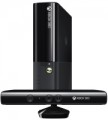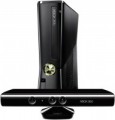Release year
The official release year of the game console. Usually, it is indicated by the date of official sale. This information allows you to determine the "age" of the device — and, accordingly, its functionality (to some extent), including within its own platform. So, for example, the difference between the Xbox One S and Xbox One X in terms of name is not particularly obvious; but knowing that the first was released in
2016, and the second —
in 2017, you can definitely determine which model will be newer and more advanced. Accordingly
, the novelties of 2020 and
2019 will be even better.
Connectors
—
mini-Jack (3.5 mm). General purpose connector, most commonly used as an analogue audio output. Simply put, in set-top boxes, such an interface is usually designed to connect headphones, speakers and other external audio accessories — a lot of such devices use a 3.5 mm plug, and there are corresponding adapters for other interfaces. At the same time, the specific functionality of the mini-Jack connector may be different. So, in some models it works only as an output, in others it can be used to connect a headset with a microphone or even a separate microphone. In addition, this connector can be combined with an optical S / P-DIF output (for more details, see "Additional").
— miniHDMI. A smaller version of the HDMI interface detailed below. It is installed in portable consoles and game pads (see "Form factor"), does not differ from the full-size version, except for the dimensions of the connector, and is used for the same purpose — to connect to a TV or other screen and transmit video and audio signals.
—
HDMI. A digital interface that allows you to simultaneously transmit high-definition video and multi-channel audio up to 7.1 over a single cable (in addition, in high quality and with a minimum of interference). It is one of the most common in modern video technology, the vast majority of TVs and monitors have at least one HDMI input. At the same time, for working with resolutions from
...HD (1280x720) and higher, this connection interface is considered optimal today. Therefore, the presence of HDMI is almost mandatory for desktop consoles with support for high-definition video (portable models do not use a full-size connector due to their relatively large dimensions).
— microUSB. A reduced (actually, the smallest to date) version of the USB interface, widely used in computer technology for connecting external devices; completely identical to the full-size version, except for the shape and dimensions of the connector. Appeared due to the fact that the original USB connector has rather large dimensions, poorly suitable for pocket-sized equipment; accordingly, among consoles it is usually found in portable models and gaming tablets (see "Form factor"). The microUSB connection is designed for the set-top box to work as a connected device, slave (for more details, see "USB 2.0"). With it, you can, for example, download new games to your device or update the firmware.
— micro USB (MHL). Connector that combines the capabilities of microUSB and HDMI (see above). It is completely identical in shape and size to microUSB, it is also compatible with a conventional USB interface and provides the same features; however, MHL can also be used for high-definition video and multi-channel audio. Such a transfer is provided through a simple adapter cable with a microUSB plug on one end and HDMI on the other; with this connection, the set-top box battery can even be recharged. MHL was created as a mobile standard and it is used, respectively, in portable models (see "Form factor"). It eliminates the need for manufacturers to provide a separate miniHDMI output for video output, which has a positive effect on compactness. However for normal operation in video transmission mode, it is necessary that the TV or other external screen also has MHL certification; however, in extreme cases, the situation can be corrected with a simple adapter.
— USB-C. A kind of USB connector, positioned simultaneously as a replacement for full-size USB and for compact microUSB. It is comparable in size to microUSB, which is why it is found mainly in portable and hybrid consoles (see "Form factor"). One of the features of this interface is a two-way connector that can be inserted into the socket by either side (unlike previous types of USB connector). In terms of purpose, USB-C is in most cases similar to microUSB; and in terms of data transfer speed and other characteristics, it usually corresponds to USB 3.0 or 3.1 (see below).USB 2.0
The number of full-size
USB 2.0 ports in the design of the set-top box.
USB is a universal interface widely used in computer technology for various peripheral devices. Full-sized USB ports, including this version, are used to connect additional equipment to set-top boxes — primarily external drives and wired game controllers. Since these ports (of all versions) are quite large, they are found exclusively in desktop consoles (see "Form Factor"). Specifically, USB 2.0 provides data transfer rates up to 480 Mbps; due to the advent of more advanced USB 3.0 and 3.1 standards (see below), it is considered obsolete and is gradually disappearing from game consoles. At the same time, peripheral devices for newer USB versions can be connected to this connector — different standards for a full-size plug are mutually compatible with each other. However it is necessary that there is enough power supply — but in version 2.0 it is relatively low.
Additional
Additional connectors provided in the design of the set-top box in addition to those described above. A set of such connectors may include, in particular:
— Proprietary ports for wired gamepads and other controllers.
— IR (IR) inputs and outputs to work with various wireless accessories.
— Digital audio outputs for multi-channel audio. The most popular standard for such outputs is S / P-DIF, it has two varieties — optical and coaxial. The optical output can be separate or combined with the Mini-Jack 3.5 mm output (see "Connectors"); its advantage is the insensitivity of the cable to electrical interference, but the cable itself is quite fragile and requires delicate handling. Coaxial (electrical) connections are not as sensitive, but are more prone to interference.
— Analogue audio and video outputs (AUX, composite, component) — these connectors can be useful for connecting outdated video equipment.
CPU
The model of the processor installed in the game console.
The processor is the main computing module of the device; the capabilities of the set-top box as a whole largely depend on its characteristics. However, it is worth noting that information about its model in game consoles is usually of a general reference and promotional nature. The fact is that set-top boxes are usually designed for a specific platform, and this implies certain requirements for the power of the hardware so that the corresponding games work normally. Of course, knowing the name, you can find more detailed information — characteristics, test results, reviews, reviews, etc. — and make the most clear impression of the capabilities of the processor; however, unless you plan to use the prefix in non-standard roles, this information is unlikely to be of real practical value. The only exception is gaming tablets (see "Form Factor"): since they are very versatile and can be equipped with a variety of programs, processor data can be useful in assessing how fast an application will run.
Note that advanced desktop set-top boxes can have multiple processors.

